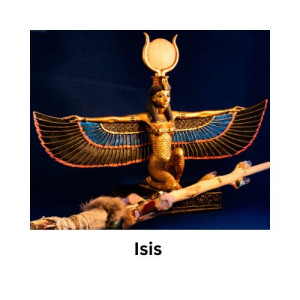by ishall dogood
Share

My family tree was jam-packed with fierce female figures who rocked my world as a kid. Picture my grandma — a force to be reckoned with! I’d tiptoe around her, terrified of properly toeing the line or being given advice on so many topics. Certainly, my behavior. Besides my grandma, there were other influential women in my life, with my mother being a significant figure.
As I journeyed through life, I began to understand the profound role of feminine energy. It was not just a concept, but a guiding force, a moral compass that I could rely on. This understanding, far deeper than my childhood perception, was a result of the strong mentorship I received from the women in my family, who drew their strength from the innate female energy present in nature.
What does “female energy” imply?
The term’ Feminine spiritual energy’ refers to the spiritual power that is associated with feminine qualities, principles, and archetypes. It is often linked with the concept of the Divine Feminine, which embodies spiritual traits traditionally associated with women and the feminine aspect of the divine.
When contemplating feminine spiritual energy, we think of goddesses, divine mothers, and feminine deities representing wisdom, fertility, compassion, and transformation. This energy emphasizes nurturing, intuition, empathy, creativity, receptivity, and connection with nature and life.
By embracing and respecting the traits of female energy, we open ourselves to a world of insights, expressions, and deeper connections with life. This journey towards a harmonious spiritual balance not only enhances our compassion and understanding but also fuels our spiritual development. The integration of both male and female energies is believed to amplify our intuition, emotional intelligence, and ability to nurture relationships.
Masculine spiritual energy typically embodies attributes like strength, action, and structure, recognizing the interdependence of masculine and feminine energies. Acknowledging the significance of energies within individuals and the universe is crucial for a holistic perspective.
Throughout history, female spiritual energy has manifested in various forms. Exploring these facets of feminine spiritual energy can offer profound insights into feminine wisdom and spirituality.
The Sacred Female in Mythology —
The Sacred Feminine in mythology represents feminine divinity and the divine feminine principle. This archetype is present in various mythologies and religious beliefs worldwide. Delving into the concept reveals its profound influence.
Qualities of the Sacred Feminine
In mythological traditions, the sacred feminine embodies fertility, nurturing, wisdom, and creative energy. Goddess figures such as Isis, Demeter, and Kuan Yin exemplify these attributes.
Connection to Nature
The Sacred Feminine is linked to the earth, moon, and natural cycles, symbolizing life, birth, and regeneration. Balancing masculine and feminine energies are essential at both individual and societal levels.
Empowerment and Evolution
Mythology, psychology, and spirituality highlight the importance of female empowerment and spiritual wisdom. These attributes are crucial for the evolution of humanity’s inherent strength and potential.
What is the Sacred Mother?
The “Sacred Mother” is a distinctive aspect of the “Sacred Female” or the “Divine Feminine,” with Mary, the mother of Jesus in the Catholic faith, being a quintessential representation of this archetype.
In Catholicism, Mary is honored as the mother of God or the “God-Bearer,” known for her purity, humility, and maternal nurturing. She embodies compassion, intercession, and divine grace, symbolizing maternal love and protection.
As the Sacred Mother, Mary embodies divine motherhood, representing nurturing, compassion, and maternal love. She provides comfort and guidance for believers, reflecting universal motherhood qualities across different cultures.
In Catholic theology, Mary’s significance surpasses her role as a biological mother; she is also viewed as a spiritual mother to all Christians, exemplifying virtues of faithfulness and obedience to God’s will. This depiction underscores her importance as a maternal love and divine grace symbol in Christian tradition.
Mary’s portrayal in Catholicism aligns closely with the Sacred Mother archetype, emphasizing her role as a symbol of maternal love, compassion, and divine grace in Christian theology and devotion.
The Goddess Athena —
The Greek goddess Athena does not neatly fit into the traditional roles of Sacred Mother or Sacred Female.
Athena is commonly seen as a goddess of wisdom, strategic warfare, and craftsmanship. Her attributes include intelligence, rationality, and prowess in warfare rather than the nurturing qualities associated with the Sacred Mother. Athena embodies wisdom, bravery, and strategic acumen, symbolizing the pursuit of knowledge and justice.
Athena is a relevant study in our modern era where women undertake roles previously reserved for men. She presents a broader perspective of the Divine Feminine, showcasing a distinct facet of feminine power and wisdom. Athena embodies traits traditionally linked with masculinity in ancient Greek society, such as safeguarding cities and warriors. Despite this, Athena remains a significant figure in mythology, often seen as a symbol of independence and self-reliance.
Athena’s depiction underscores the range of feminine archetypes in mythology, illustrating that the divine feminine can manifest in diverse ways beyond conventional motherhood or fertility roles. She exemplifies qualities that transcend typical gender norms, emphasizing the intricate and multifaceted nature of the feminine principle in myths.
While Athena may not directly correspond to the Sacred Mother or Sacred Female archetypes, she presents a distinct and potent representation of feminine divinity that highlights the variety of mythological depictions of women and their roles in ancient civilizations.
I used Athena in my Crystal Ball example in my book Become the Boss of You for these reasons.
The crystal ball – The Goddess Athena
I’ve got a whimsical tale about a magical crystal ball! Picture this: one night, as I was wrapping up a bedtime story for my little one, he begged for more. Smelling a bedtime stall tactic, I jokingly suggested consulting a crystal ball for the answer. Intrigued, he prodded me to spill the beans, and I spun a yarn about a mystical fairy hidden within the ball, much like Santa Claus. Playing along, I would sneak off to “consult” the crystal ball and return with sage advice from the fairy, nudging him to hit the hay. This enchanting bedtime ritual turned into a game where he’d occasionally be allowed to stay up later. With the help of my new make-believe sidekick, bedtime became more of a magical adventure for both of us!
In my adult life, I adapted this game for personal use. Whenever I faced a dilemma or sought a fresh perspective, I would imagine consulting historical figures like Athena or Ben Franklin through my crystal ball. This imaginative exercise helped me explore different viewpoints and delve into my subconscious to uncover insights I might have overlooked.
Here is an example from my book:
- Me: “Athena, as the goddess of wisdom, do you have any thoughts on how I can help the readers understand the next steps they should take to get the most out of the book?”
- Athena: “Well, have you considered giving them a specific example of your thought processes?”
- Me: “I’m not sure exactly what you mean by that.”
- Athena: “You might start by sharing some journalling thoughts on the tools you have been exploring in the chapter or condensation of one tool from your perspective.”
- Me: Wow! “That could work.”
- Athena: “Quit acting like you don’t think the idea is brilliant. There is a reason you asked. You conjure me up because you have writer’s block. Don’t you think I know that? By the way, you should also add a specific copy of a daily to-do list.”
Me: “You are right. I’ll leave the examples at the end of the chapter and on the website. Oh, by the way, thanks!”
I hope you enjoyed this article.
Peace, Ishall Dogood.
Top of Form
Source:
To read more about The Divine Female or Sacred Feminine in mythology and spirituality, Google “The Great Cosmic Mother: Rediscovering the Religion of the Earth” by Monica Sjoo and Barbara Mor.
by ishall dogood
Share
STAY IN THE LOOP
Subscribe to our free newsletter.
Leave A Comment
Mindfulness Chapter five of the e-book “Become the Boss of You” is dedicated to the things that improve all the other aspects of your life. With that vibe in mind, here are two mindfulness hacks to enhance your daily adventures. These easy techniques can unlock your potential and help you become mindful. Mindfulness, born in the […]
The New Moon and You – Starting your cycle of renewal Have you ever thought it might be a good time to start a change for the better? Most have at one time or another, but what is the right time to start? Is there best time to start? Our world has become busy, filled […]
Once in a Blue Moon (Written on 8-19-24) Ever heard of the saying “Once in a Blue Moon”? But what about the elusive Super Blue Moon? Probably not, because it’s a rare treat happening right now as we speak. How cool is that? Don’t go picturing a blue-colored moon – the term “Blue Moon” is […]
Work smarter, not harder Our book, ‘Become the Boss of You,’ highlights many insights. One treasure trove of wisdom is the latent power of the subconscious mind. Harnessing the subconscious mind unlocks a crucial aspect of effective life management. Unleashing this powerhouse within us can be a secret weapon, a genie that can work with […]










